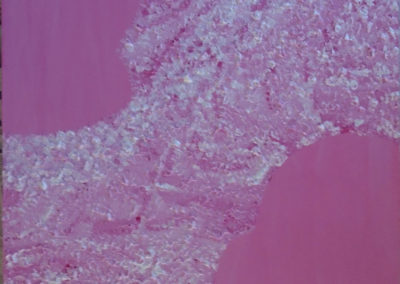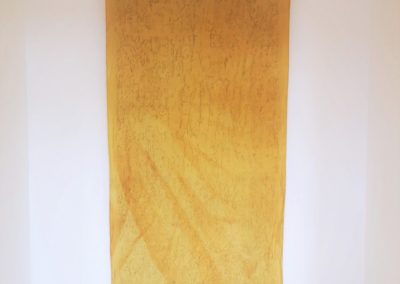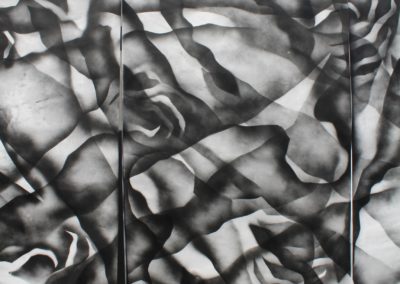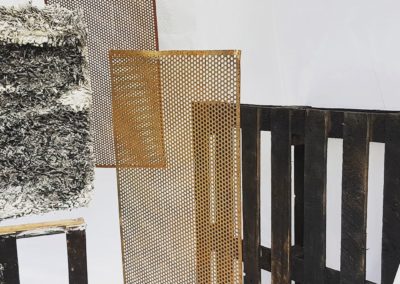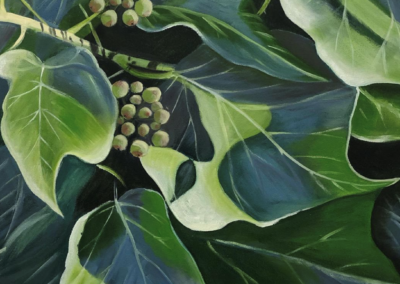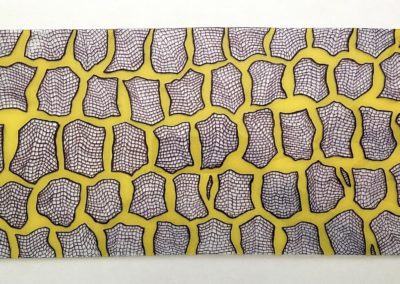
‘Not The Degree Show’ sees a selection of work from the graduates of the 2020 Greater Brighton Metropolitan College BA (Hons) Fine Art. Due to the global pandemic the original degree show at the West Durrington Campus in June was cancelled, however the show was taken online to hold the college’s first ever ‘virtual exhibition’. This will be the first time the graduates have exhibited their work since completing their degrees this Summer.
Now that lock-down measures have been lifted, the group are delighted to exhibit some fantastic, high quality artwork from ten diverse artists.
You can find out more about the artists below and on their personal websites, blogs and social media.
Open Tuesday – Saturday // 10.00 – 17.00 (Closed Mondays and Sundays)
Kathryn Best
Kathryn Best’s work has been, and continues, to be inspired by the Sussex countryside and has chosen to focus on the colour of the flora found on the Downland pathways and meadows near where she lives.
She creates colourful abstract paintings of sections of wild rose bushes. The heightened colour creates the sense of walking through a spring meadow, along a path surrounded by blossom on the trees or over a path covered in autumn leaves whilst there are still plenty on the trees. They are inspired by an emotional response to the environment and aim to inspire the viewer to visit the countryside and see it in a fresh light whilst encouraging them to conserve the natural world.
Kathryn’s paintings exemplify the beauty of Sussex, beyond the Worthing boundaries, which are so close but yet seeming to be so far away.
Ella Wenzel
Ella Wenzel is a recent BA Fine Art graduate located in Worthing. She specialises mostly in contemporary drawing, but tends to experiment with a range of different paints and drawing tools that are often implemented on paper, board, Perspex, acetate and varied other grounds. Her avant-garde pieces are often detailed and heavily rely on pattern and linear markings to achieve her desired aesthetic. She initially recognised the extent of her enthusiasm for linear detail after running low on ideas for a project at university, which resulted in her pinning a ‘mindless doodle’ onto her studio wall. These doodles started with drawing a single, asymmetric line and following on from there, until achieving either a sense of flow or rhythm amongst the line work. This practice became a therapeutic habit that quite quickly established itself into the further-refined style that Ella works with today.
After uncovering her niche, Ella invested in her first mini microscope which only deepened her interest in working with detail. The use of a microscope provided her with another level of visual imagery to work from, and soon shaped her subject matter into becoming more scientific. Some of her inspiration will derive from content found in a biology textbook, whilst it can also be found through methods such as raiding her wardrobe to find materials to examine closely under her microscope lens. This imagery is then used to often manipulate and exaggerate in scale and/or colour when producing a new piece; sometimes leaving the end result unrecognisable to the observer in comparison to its original form.
Jennifer Rogers
Jennifer Rogers is a multidisciplinary conceptual artist, currently exploring the ‘in-between’ and liminality in relation to displacement, migration and colonialism.
Materials, exploration, process and research are integral to her practice. She enjoys examining the histories of a place or country and exploring the natural geological and biological materials from the respective areas. Having grown up in South Africa, she finds it important to create projects using materials that retain nostalgic value and serve the memory growing up there. These materials have been used in conjunction with counterpart objects found in the United Kingdom.
Jennifer has always found the intangible, ephemeral, transient and chance elements interesting in her work. These relate to the fragile memories of location and identity and how you can’t quite see, control or hold onto them with any permanence, like mist unfurling and dissipating.
Her current practice involves the exploration of the void between actions, journeys and material states. The investigation into a place of transition between what was and what will be, at the point of change, the thresholds, edges and borders is Jennifer’s current focus.
Nicola Brewerton
Nicola Brewerton is exhibiting work created from material gathered during one year at Clayton Wood Natural Burial Ground where her mother – who passed on her love of plants – is buried.
Exploring the wildness of a place that is special to Nicola. She gathers small amounts of wild plants and materials and captures photographs often from unusual angles. Using distilling and fermenting techniques to make dyes and inks for paper and fabric allows Nicola to create images using eco-printing methods. Nicola works alongside nature, passing within it and letting it make its own marks.
Her work is a celebration of the tiny uniqueness of each plant and the small joys it gives us. It is often a glimpse of what we might not notice. Nicola’s interest in exploring natural cycles, seasonal growth and dying back, the constant renewal and energy of plants is evidenced in her latest works. This has culminated in her latest project working within a burial ground, where the human bodies buried are part of this cycle.
Sonia Srebric
Sonia Srebric’s current studio practice is photography based. Her current work explores identity as women and targeting by the beauty industry through advertising. This is often advertising for expensive products and accessories. Most of these products are luxuriously presented and packaged but discarded once empty.
Sonia has preserved the aesthetic quality of perfume bottle sculptural form by capturing images with photography and reworking them further into paintings.
Della Clarke
Having a life long relationship with the natural world, Della Clarke’s work is inspired by the importance of respecting its beauty and life-giving force on which we all depend. As an artist, Della wants to depict the verdant aliveness of plants and their oxygen producing capacity – whilst also containing an environmental message. Trees are a huge inspiration; they are the oldest and largest species in the landscape and are a focal point that gives the landscape interest.
Through these oil paintings and charcoal drawings Della’s passion for conserving nature and fascination with the intricacies and complex structures of living things is evident. In her current work, Della has honed in on the leaves of tropical plants that have evolved to be an important part of the global ecosystem and to remind us of the wonder and complexity of life on Earth with the aim to uplift the viewer.
Rhianna Wass
Rhianna Wass’ practice primarily focuses on death. Rhianna is currently focusing on graves and burials, including mass burials. Her work is inspired by how bodies might look once forgotten underground. Rhianna’s installations seem to have a slippage between drawing/painting and sculpture and use both 2D and 3D effects.
Rhianna uses liquid latex, for its unsettling skin-like quality in its touch and its colour. It lends itself well to her practice as it creates distorted, almost ghost-like figures. One of the inspirations for this visual language would be Francis Bacon, a painter whose work has stuck with her throughout her degree.
Circe Gomez Oliveros
Circe Oliveros Gomez’s work is the exploration of her own identity and life’s existence. Using a different range of materials and mediums such as photography, clay, wood, wire, cord, fabric, acrylic and oil paint on canvas, has allowed her to explore and develop her own techniques, thereby discovering a dialogue that speaks to her and to others in an abstract way.
Circe’s Mexican heritage is a massive inspiration and using strong colours influenced by Mexican folk art has evoked a lot of passion and nostalgia within her.
Other influences are contemporary artists including American mixed media artist Jim Drain, the British-Indian artist Anish Kapoor, German painter Anselm Kiefer, French artist Louise Bourgeois and American artist Mindy Shapero.
Her main aim is to continue exploring and practicing my own techniques. Circe likes to express herself through abstract figures, sculptures and paintings, in order to communicate with the viewer.
Fingas Art
What is the effect of industrialisation on our planet? Are we doing something wrong? Can we help our planet? Fingas Art tackles
some of the main issues of industrialisation and our lifestyle which affect the health of our planet.
In collaboration with a local youth club, he informs the future generation of the importance of nature in our day-to-day life, and the urgent need to help our natural environment – even if it’s just a small gesture like recycling our everyday materials that we use. Fingas Art uses materials raw from nature such as soil, beeswax, sticks, salt or coal; but also those found in the environment, or produced by industry, for example pallets or rubbish, like plastic bottles and boxes.
His work puts together the issues of nature, industrialisation and ecology, looking at the entire storyline behind the extraction of natural minerals, industrial uses of materials and their end destination. In many cases these materials end up in our nearby forests, parks and waters and put wild animals at risk of death.
Victoria Waldron
Having a fascination for textures, Victoria Waldron’s loves to use materials that convey a feeling of comfort and pain. She is interested in creating physical forms for things that would not normally have a physical body, such as human emotion.
Inspiration comes from childhood memories; Using writing from my journal as a framework in her practice. Victoria likes to create three dimensional work, using materials that mimic the fragility and lack of permanence of life.
Victoria has also created short films to accompany my 3D work, occasionally merging the two, making wearable sculptures for performance and film. Currently she has been exploring my own relationship with humour as a coping mechanism for depression, and exploiting mental struggles through cathartic techniques.

